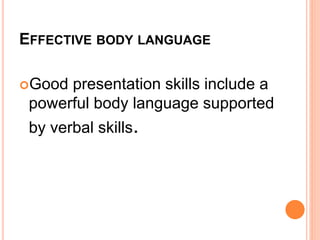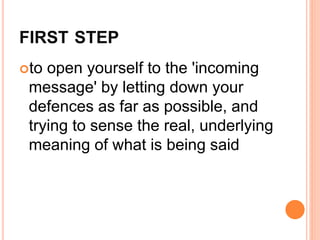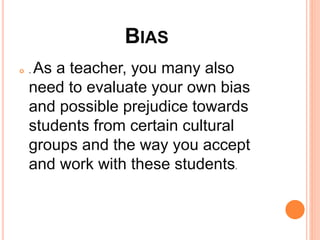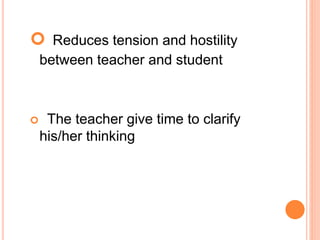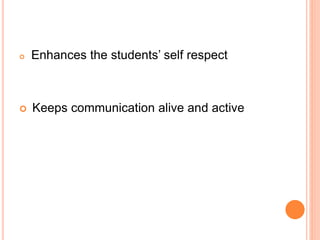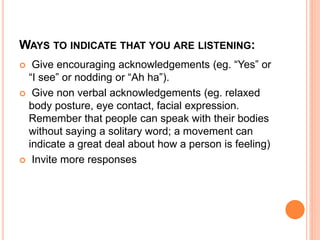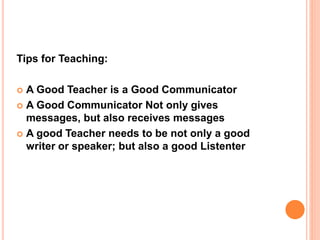_Communication-Skills
- 2. COMMUNICATION `SKILLS Exchange of thoughts and ideas with the intention of conveying information.
- 3. IMPORTANCE OF COMMUNICATION SKILLS Must be realize that all students have different levels of strength and weaknesses.
- 4. EFFECTIVE COMMUNICATION SKILLS Positive motivation -it is the job of teachers to create enthusiasm and interest in the minds of students towards a subject.
- 5. EFFECTIVE BODY LANGUAGE Good presentation skills include a powerful body language supported by verbal skills.
- 6. TEAM FORMATION This is a good method where you can divide the student into small team and ask them to solve different problems.
- 8. LISTENING SKILLS An effective classroom leader or lecturer is not only a knowledgeable and skilled teacher he or she is a good active listener.
- 9. STAGES OF LISTENING Probably the simplest way to start thinking about listening is to break down the process into stages. In practice, no one would keep strictly to these stages, but reflecting on them should improve a person’s listening skills
- 10. FIRST STEP to open yourself to the 'incoming message' by letting down your defences as far as possible, and trying to sense the real, underlying meaning of what is being said
- 11. SECOND STEP is to begin to interpret, or reconstruct, what is being said, remembering always that words have different meanings to different people.
- 12. THIRD STEP is to evaluate what is being said, only after you have made a reasonably objective interpretation of the message.
- 13. FOURTH STAGE is responding. Here you demonstrate that you have truly been listening
- 14. OBSTACLES TO LISTENING It is important to be aware of the obstacles to listening in the classroom
- 15. ANXIETY AND DISTRACTION Listening, like learning, is difficult in an atmosphere of anxiety, tension or boredom.
- 16. BIAS . As a teacher, you many also need to evaluate your own bias and possible prejudice towards students from certain cultural groups and the way you accept and work with these students.
- 17. LANGUAGE PROBLEMS Many classrooms have at least some students from Non-English speaking backgrounds whose native language is not English.
- 18. *Despite this, genuine communication between teacher and student can only occur by showing a willingness to try to understand the students’ feelings. Empathic listening in the classroom:
- 19. Reduces tension and hostility between teacher and student The teacher give time to clarify his/her thinking
- 20. Enhances the students’ self respect Keeps communication alive and active
- 21. WAYS TO INDICATE THAT YOU ARE LISTENING: Give encouraging acknowledgements (eg. “Yes” or “I see” or nodding or “Ah ha”). Give non verbal acknowledgements (eg. relaxed body posture, eye contact, facial expression. Remember that people can speak with their bodies without saying a solitary word; a movement can indicate a great deal about how a person is feeling) Invite more responses
- 22. Don’ts for group listening: Don't interrupt Don't change the subject Don't rehearse in your head instead of listening Don't interrogate Don't teach or preach Don't give advice Don’t talk down to students. They can sense when the teacher is not on their level and may not respond appropriately
- 23. Tips for Teaching: A Good Teacher is a Good Communicator A Good Communicator Not only gives messages, but also receives messages A good Teacher needs to be not only a good writer or speaker; but also a good Listenter
- 24. YOU ARE NOW A GOOD LISTENER Thank you for Listening




